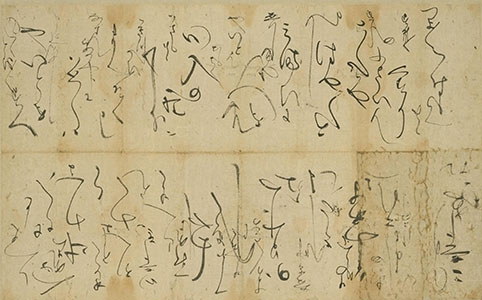Special Exhibition HOSOKAWA Gracia
HOSOKAWA Gracia, (1563-1600)
 Born as a daughter of Akechi Mitsuhide and known as the wife of Hosokawa Tadaoki, Hosokawa Tama was baptized in 1587 and received her baptismal name, Gracia (Latin word meaning ‘Blessing of God’). When her husband joined the Tokugawa side (the Eastern Army) during the Battle of Sekigahara (the battle fought between the army of Tokugawa Ieyasu and the alliance of anti-Tokugawa feudal lords over the hegemony of Japan), the leader of the Western Army, Ishida Mitsunari, ordered Gracia to present herself at Osaka Castle as a hostage. Gracia refused and stayed in the Hosokawa residence located in Tamatsukuri, Osaka, and had her servant help take her own life at the age of 38.
Born as a daughter of Akechi Mitsuhide and known as the wife of Hosokawa Tadaoki, Hosokawa Tama was baptized in 1587 and received her baptismal name, Gracia (Latin word meaning ‘Blessing of God’). When her husband joined the Tokugawa side (the Eastern Army) during the Battle of Sekigahara (the battle fought between the army of Tokugawa Ieyasu and the alliance of anti-Tokugawa feudal lords over the hegemony of Japan), the leader of the Western Army, Ishida Mitsunari, ordered Gracia to present herself at Osaka Castle as a hostage. Gracia refused and stayed in the Hosokawa residence located in Tamatsukuri, Osaka, and had her servant help take her own life at the age of 38.
1 Hosokawa Tadaoki fujin shokan (from Hosokawa Tadaoki do fujin to shojo), [Azuchi-Momoyama period][WA25-35]
This particular letter was written by Hosokawa Gracia, and was addressed to Kojiju. Kojiju was a waiting maid appointed to serve Gracia by the Akechi Family upon her marriage to Hosokawa Tadaoki. Kojiju later married Hirata Inaba, a vassal of the Hosokawa Family. The letter is elegantly hand-written in a beautiful kana-chirashi style (a style in which different types of kana are used and written in irregular composition), and the contents show Gracia’s subtle thoughtfulness toward her servant.
The National Diet Library owns a total of twenty letters, which consist of ten letters written by Gracia, eight by Tadaoki, one by their third son Tadatoshi, and another one by Ryuin, their fourth son. All the letters were previously kept by either the Hirata or Matsumoto families, which are related to Hirata Inaba, to whom Kojiju was married.
Chirashi-gaki
Hosokawa Tadaoki fujin shokan (Letters of the wife of Hosokawa Tadaoki) was written in an irregular format that was not aligned with the margins of the page. At first glance, this style of writing appears disorderly but actually has its own logic, and the larger characters are intended to catch the reader’s eye first.
Although the true origins of this style are unknown, it is said to have existed even before the Heian period.
Sizes and types of paper
Japanese washi is made in a standard-size mold, and this size is called tategami. The term origami refers to a sheet of washi folded in two and on which words are first written with the crease at the bottom. To continue writing, the paper is turned over and the crease once again placed at the bottom, so that when the letter is unfolded, these two sections are read in opposite directions.

Kirigami is a strip of paper made by cutting origami at the crease. When multiple strips of kirigami are connected together, it is called tsugigami. A long strip of tsugigami can be rolled up to make makigami, which was commonly used in the late Edo period. Many people think that the practice of unrolling a letter as you read it originated in ancient times, but apparently this practice is not that old.







